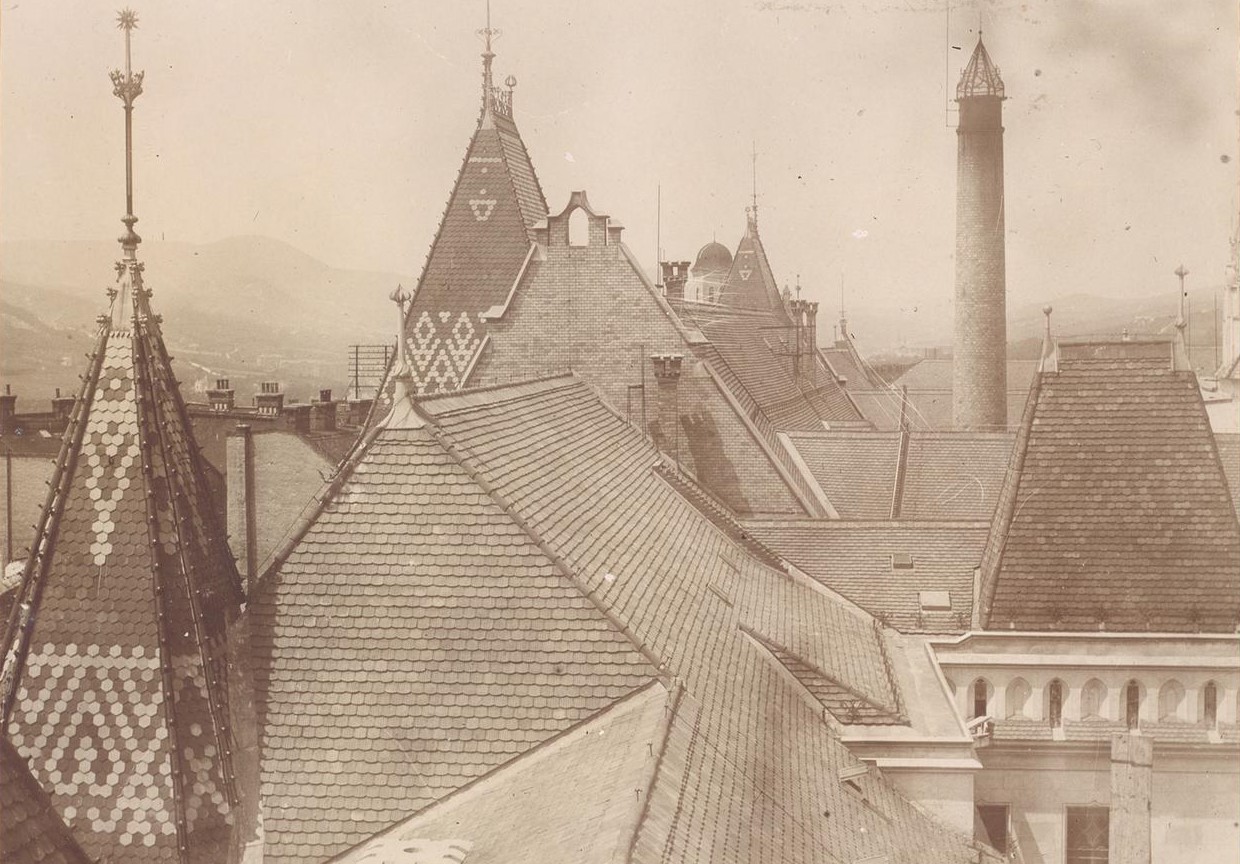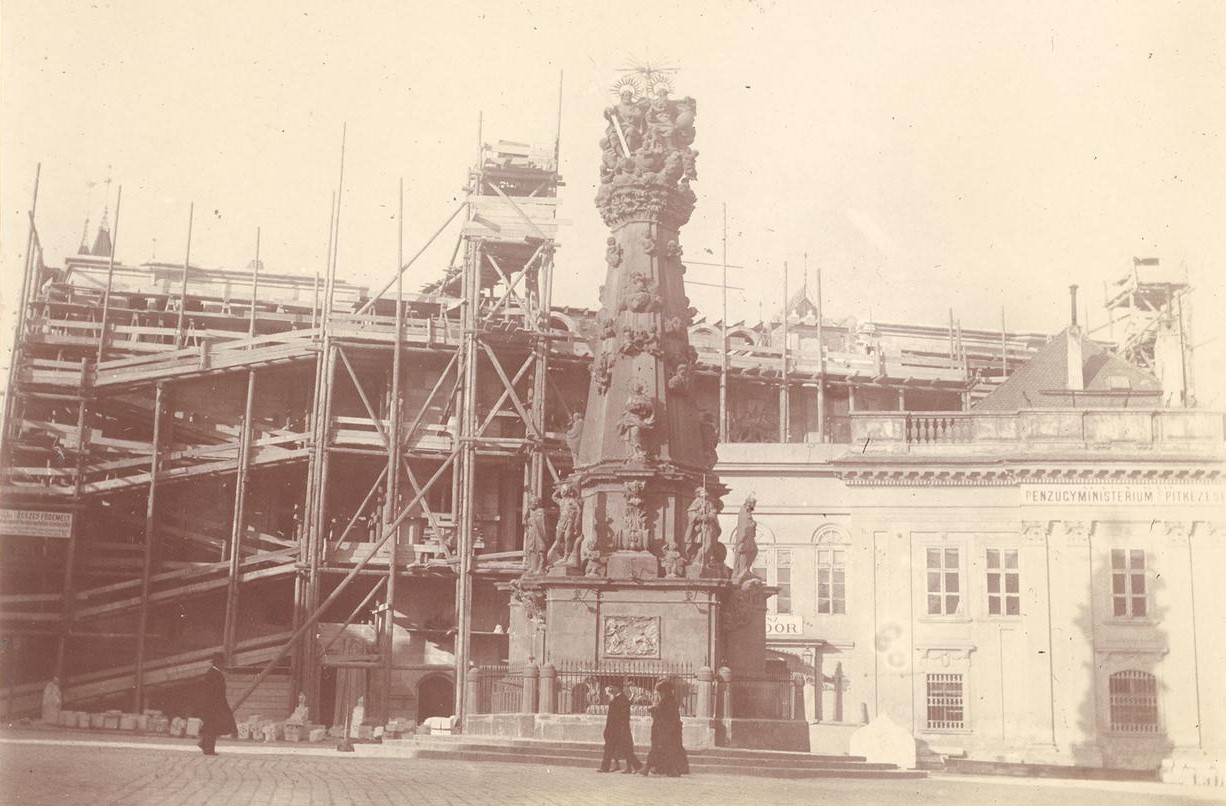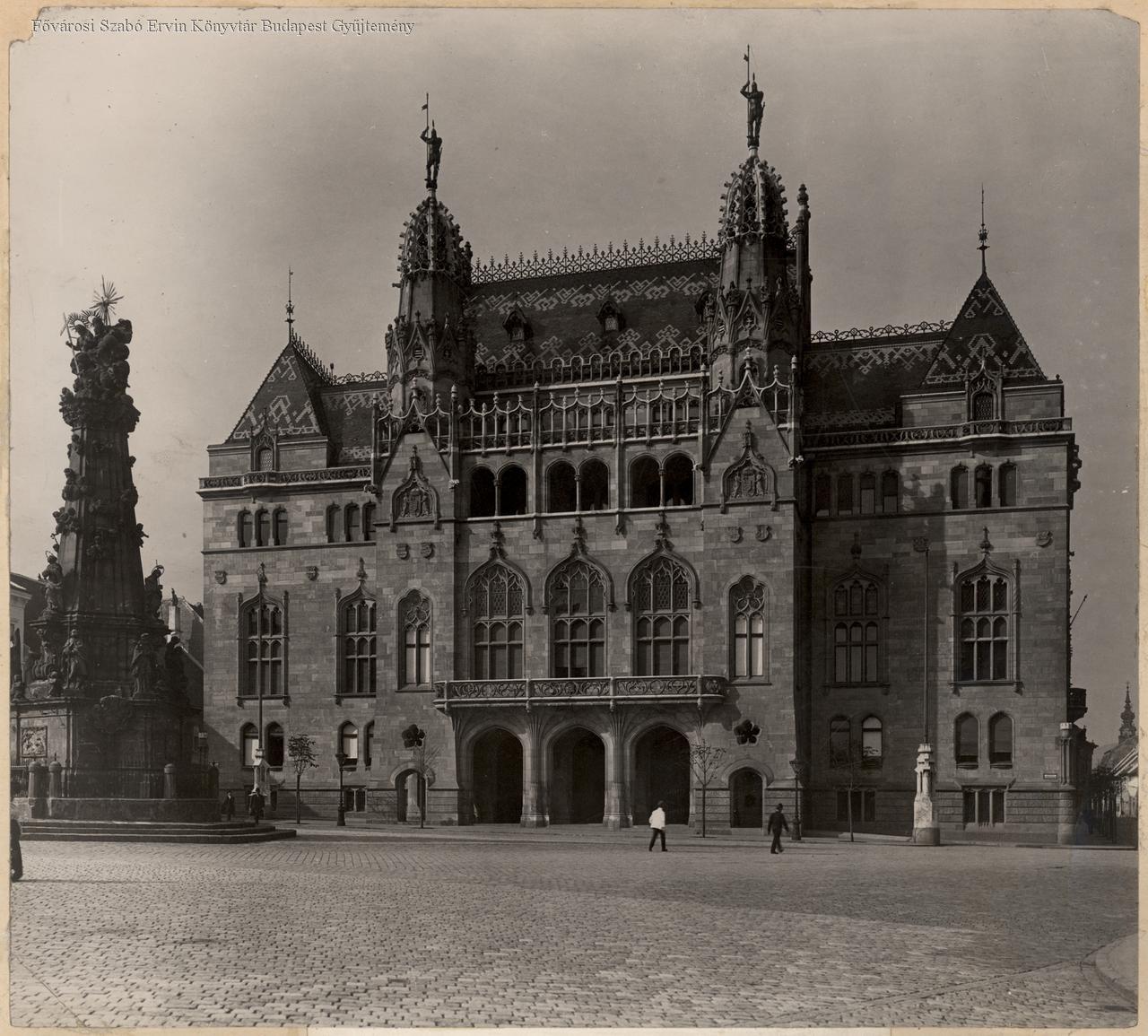Architect Sándor Fellner announced on 7 October 1907, 115 years ago, that the works had been completed regarding the new Ministry of Finance palace at Szentháromság Square in Buda Castle. This marked the end of the construction that had been going on since the beginning of the century.
Of course, the construction of the palace did not begin with the foundation and the erection of the walls, but with expropriation and demolition work. Along Országház Street, which runs west of today's Szentháromság Square, and in Fortuna Lane, the Budapest Public Works Council appropriated a total of 10 properties, for which the legal affairs of the Ministry of Finance were handled by the Treasury Legal Directorate. The expropriations began in January 1901 and ended in November. This was followed by the demolition of the state-owned buildings, which was carried out by the demolition contractor Bernát Grünwald. The last building demolished on 11 January 1902 was the Majláth House on Szentháromság Square, the building of Stefánia Prandau, the widow of Judge Royal György Majláth.
Of course, the construction work of the new Ministry of Finance palace in the future north wing was already in full swing at that time. For practical reasons, the former Jesuit academy building on Szentháromság Square was demolished later - in which, after the Jesuits, the leaders of the Hungarian Chamber and the Ministry of Finance worked - because the Construction Committee managing the works was located here, and the two-story building was also used for storage.

On the right side of the picture is the former Jesuit academic building, later the old Ministry of Finance on Szentháromság Square, next to it on the left is the Majláth House. Both buildings were demolished at the very beginning of the 20th century (Source: FSZEK Budapest Collection)

Demolition of the old building of the Ministry of Finance (Source: FSZEK Budapest Collection)
The first entry in the construction diary was made on 5 October 1901, a beautiful, sunny Saturday, which can be seen from the fact that the weather conditions were also recorded in the diary, as it also affected the construction process. However, winter and frost did not and could not be an obstacle, construction did not stop even then. In the case of frost, concreting was suspended, but heated work areas were created, and warm water was used for construction materials. On the already mentioned 5 October, the borders of the construction site were marked out, the levelling, in contemporary terms, the slope-measuring was carried out, and at the same time, the floor height of the ground floor of the new building was determined.
Sunday has been a public holiday in our country since 1891, because the first paragraph of Article 13 of 1891 stated that "industrial work must be suspended on Sundays and King St. Stephen's Day, as a national holiday, in the lands of the Hungarian Holy Crown". Therefore, further substantial work on the construction site was carried out starting on Monday, 7 October, with 14 people at that time, but later with more than 30 people. During this period, the first test drillings prior to the foundations were carried out, looking for a solid surface on the rock of Várhegy.
The construction was symbolically started by State Secretary Béla Graenzenstein, the chairman of the Construction Committee of the Ministry of Finance, on 10 October 1901, with a hoe cut, which took place in the middle of the future main wall at F Wing, located at the corner of Fortuna Lane and Pázmány Péter Street (partly today's Hess András Square).

The foundation works of the new palace of the Ministry of Finance (Source: FSZEK Budapest Collection)
The foundation stone was laid on Tuesday, 15 April 1902 at noon, which was reported by several newspapers. People interested in the construction were present at the important event: Minister of Finance László Lukács, the already mentioned State Secretary Béla Graenzenstein and Sándor Fellner, the designer of the building, as well as State Secretary Alfréd Toepke and ministerial advisor Ferenc Vértessy, as well as other officials and people working on the construction. And in addition, those citizens who were curious about the famous event.
The foundation stone was made of hollow limestone with parameters of 0.80 x 0.70 x 0.51 metres, and various things were placed in the bronze urn placed in its cavity. Among them are the signed documents containing the history of the construction, which probably also included the bird's-eye view of the future building mentioned in the construction diary. In addition, they included one copy of each of the Hivatalos Közlöny and daily newspapers, as well as the gold and silver coins in circulation at the time.
Béla Graenzenstein and Sándor Fellner gave speeches on the occasion of the important event, which were received by László Lukács. After that, the foundation stone was laid, which was placed in the ground by Géza Majorossy, the construction manager, and master builder Nándor Kunfalvi, after the signal from the Minister of Finance. Then each of them individually struck three blows at the stone. At that time, more than 200 people were working on the construction site.

Raising the first foundation wall of the Ministry of Finance building (Source: FSZEK Budapest Collection)

Construction on the first floor: installation of door and window frames. Many times more than 200 people worked at the same time (Source: FSZEK Budapest Collection)
On Saturday 9 July 1902, a storm hit the city, which did not spare the future building either. Everyone could consider the fact that lightning struck the building as an ominous or lucky sign, but it only damaged a small part of the third floor and - fortunately - did not cause any major damage. The damage was quickly repaired.
The construction progressed exceptionally quickly, so that on 19 September 1902, the topping-off ceremony (German: Gleichenfest), could be held, on which occasion the workers received a monetary reward. Moreover, since this day was the 100th anniversary of the birth of Lajos Kossuth, they also had a day off.

The placement of the iron beams on the attic level of the building (Source: FSZEK Budapest Collection)

The roof of the courtyard is being built at the western corner of the main wing on Szentháromság Square. Enamel tiles delivered from the Zsolnay Factory were placed on the Szentháromság Square side of the building (Source: FSZEK Budapest Collection)
In the summer of the following year, the tiling works were already underway, and tiles delivered from the Zsolnay Factory were placed on the Szentháromság Square side of the building, drawing a colourful pattern. This type of roofing was used several times in other buildings in Budapest (for example, the Museum of Applied Arts, later the building of the National Archives), but in the case of the Palace of the Ministry of Finance, it can be interpreted as a reflection on the roof of the neighbouring Mátyás Church, apart from being an independent entity.

Construction is already underway on the upper floors. In the background, on the left, the former Jesuit college can be seen, the later Chamber's building, and the rebuilt Mátyás Church (Source: FSZEK Budapest Collection)

The roof of the northern building block (Source: FSZEK Budapest Collection)
11 October 1902 was also considered a significant day. On the side of the building facing Szentháromság Square, two towers rose, on the top of which - as can be clearly seen in contemporary photographs and architectural plans - was a copper statue, a copper soldier. They got their name from the fact that the copper statues formed a warrior figure. Of course, for the sake of stability, they were not only fixed but also placed weights in them. On 11 October, completion documents related to the construction were placed in one of the two statues.

The roof of the main facade of the finished building overlooking Szentháromság Square, which comes from the Zsolnay Factory, forms a colourful pattern. At the top of the building's tower are the two copper statues, one of which housed documents. Detail from Mór Erdélyi's photo (Source: FSZEK Budapest Collection)
The construction itself proceeded from the north wing of the building to the south, i.e., from Fortuna Lane to Szentháromság Square. Thus, in July 1904, the rear, northern part of the building was handed over first. The construction of the rest of the palace was completed on 4 December 1904. After the authorities inspected the building, the occupancy permit was issued on 18 April 1905. That year and the following year, the interior spaces were furnished. Subsequent repairs were also carried out, and on 7 October 1907, the architect Sándor Fellner reported that all the work had been completed.
During the restorations following World War II, the house underwent significant changes and was stripped of many of its decorations. Currently, the complete reconstruction of the building dreamed up by Sándor Fellner is taking place, during which the palace wing will also be reborn and regains its former, beginning-of-the-century appearance.

The new replacing the old. The new palace of the Ministry of Finance is being built behind the scaffolding. Next to it to the right is the former Jesuit academy, later the building of the Ministry of Finance, which is still awaiting demolition (Source: FSZEK Budapest Collection)

The new palace was completed in its entirety on 7 October 1907 (Source: FSZEK Budapest Collection, recording by Mór Erdélyi)
Cover photo: The new palace of the Ministry of Finance built between 1901 and 1907 (Source: FSZEK Budapest Collection)




































Hozzászólások
Log in or register to comment!
Login Registration